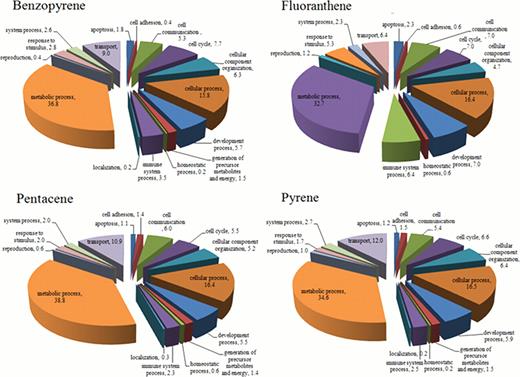Abstract
Abstract 4690
Polycyclic aromatic hydrocarbons (PAHs) are one of the major environmental hazardous compounds in living environment generated by combustion of fossil fuels. PAHs are classified as carcinogens by International Agency for Research on Cancer. However, the study on biomarkers and biological effect of PAHs has not been thoroughly studied in peripheral blood stem cells (PBSC) and leukemia cell lines. Therefore, the present study investigated biological characteristics and biomarkers in hematopoietic cells and leukemia cell lines after exposure of PAHs.
Cytokine stimulation (10 mg/kg/d) was used in a 28-year-old healthy male donor from 5 d before to 2 d after. One to three apheresis procedures were planned for on day 0, day 1, and day 2, using a Baxter CS-3000 PLUS machine (Baxter Healthcare) and a COBE-Spectra (Gambro). PBSC and three leukemia cell lines (THP-1, Molt-4 and K562) were cultured in RPMI media containing 10% fetal bovine serum. In this study, four types of PAHs- Benzopyrene (BaP), Pentacene, Fluoranthene and Pyrene -were added in the cell culture media with 100μM concentration (Sigma-Aldrich, USA). Cell count was performed using an automated blood cell analyzer. Viability and apoptosis were assessed by trypan blue dye exclusion test and flowcytometry based on annexin V staining protocol. Cytotoxicity was determined by the water-soluble tetrazolium salts -1 assay. Proteomics in mitochondrial-rich cytoplasmic fraction was performed using nano-LC-ESI-MS/MS analysis. The acquired fragment spectra were searched in the BioWorksBrowser (version Rev. 3.3.1 SP1, Thermo Fisher Scientific Inc., CA) with the SEQUEST search engines against National Center for Biotechnology Information (http://www.ncbi.nlm.nih. gov/) non-redundant human database.
Depending on the type of PAHs, each cell count showed different aspects. In comparison to control group, Fluoranthene displayed profound significant reduction in cell count, especially in PBSC and THP-1 cells. Viability decreased significantly after two days of exposuring into Fluoranthene. On the third day of PAHs exposure, viability reduced remarkably in all the cells. Each type of cell lines displayed different proportionality of apoptosis. Several hundreds of PAHs exposure biomarkers were identified in comparison to control group. The notable biomarkers for PAHs exposure were displayed as following: prelamin-A/C isoform 3 and annexin A1 for BaP; prelamin-A/C isoform 3 and DNA topoisomerase 2-alpha for Pentacene; poly [ADP-ribose] polymerase 1 for Fluoranthene; talin-1 and DNA topoisomerase 2-alpha for Pyrene. By using Gene Ontology tool, we further identified protein candidate biomarkers for PAH exposure.
This study shows new biomarkers and biological characteristics of polycyclic aromatic hydrocarbons exposure in hematopoietic tissue. Specifically, talin-1 was identified as universal biomarker for PAHs exposure.
Functional grouping of protein candidate biomarkers for PAH exposure.
Functional grouping of protein candidate biomarkers for PAH exposure.
No relevant conflicts of interest to declare.
Author notes
Asterisk with author names denotes non-ASH members.


This feature is available to Subscribers Only
Sign In or Create an Account Close Modal